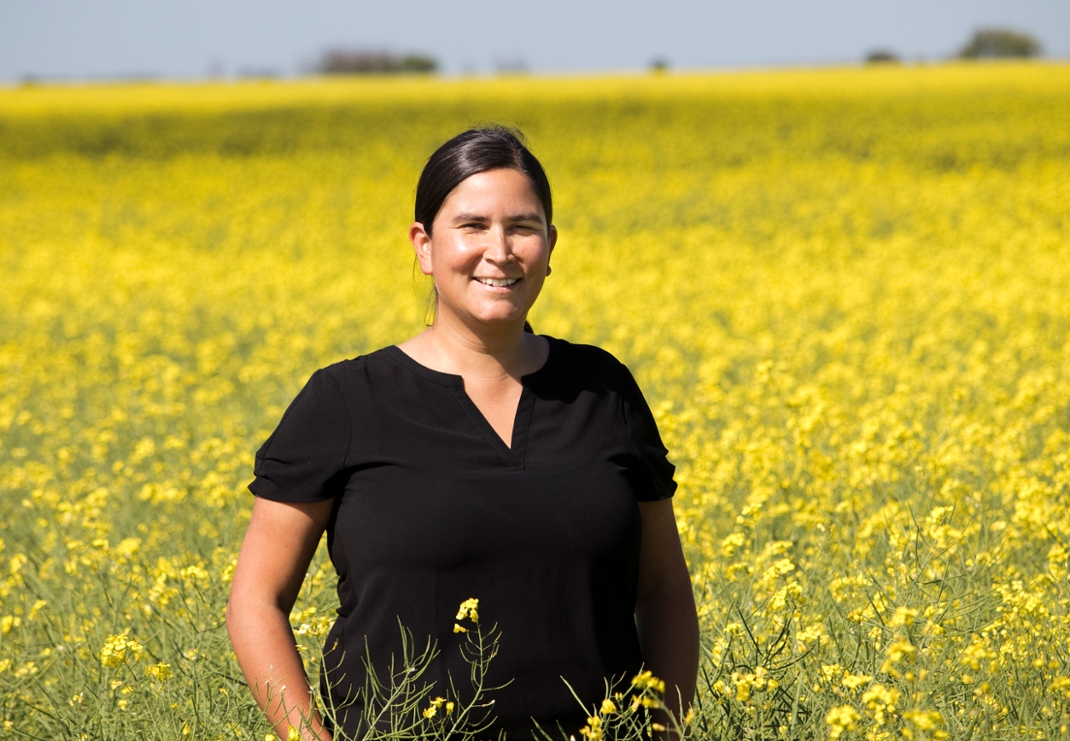Agriculture is grounded in indigenous communities
There’s great opportunity to further Indigenous agriculture in Saskatchewan. As much as four million acres of reserve lands, much of it suitable for agriculture, are located in Treaty 4 and 6 territory. To that end, the first Forum on Indigenous Agriculture in Saskatchewan was held last December.
By JENN SHARPPhotography: Richard Marjan
Melissa Arcand (PhD’13), assistant professor and soil scientist in the College of Agriculture and Bioresources, was awarded $34,000 through a new federal tri-agency grant for Indigenous Research Capacity and Reconciliation. She collaborated with fellow USask colleague and various Indigenous organizations to hold the two-day event at Wanuskewin Heritage Park.
Arcand was overwhelmed with the forum’s support from Indigenous communities.
“It was nice to know there was demand for people to discuss issues around agriculture as it relates to First Nations within the community level.”
Indigenous leaders, land managers, farmers, non-profit organizations and researchers, as well as USask researchers, and federal and provincial officials, shared information on everything from commercial farming operations to community gardening programs.
The forum combined information gathering with community engagement.
“We weren’t prescriptive about what Indigenous agriculture can be,” she said.
Presenter Sheldon Wuttunee, president/CEO of the Saskatchewan First Nations Natural Resource Centre of Excellence, said the forum was a significant way to bring communities together.
“Farming and agriculture for Indigenous people is an important concept past, present, and future. The essence of agriculture is fundamental to the signing of our treaties.”
While some Indigenous people were against cultivating the land, there were families farming before the treaties were signed. Arcand said historical accounts show these people were good farmers.
There are several stipulations in the Indian Act (enacted in 1876) that inhibited Indigenous participation in agriculture.
“A major barrier to individual people engaging in conventional agriculture as a business is the fact that on the reserves, we don’t own our land,” said Arcand. “It’s not capital that we can use to leverage for loans for machinery, or high capital activities that are part of farming.”
Wuttunee said, “as people moved on to reserves, agriculture was to take the place of hunting, fishing, trapping and gathering as a way of sustenance.”
However, policies like the pass and permit system, which restricted movement off reserves and made selling any food grown on the reserve difficult, and the Soldier Settlement Act made successful Indigenous agricultural ventures difficult in Saskatchewan.
The Soldier Settlement Act allowed the government to purchase land from Indigenous communities for veterans returning from war to homestead.
“Many sales were coerced or negotiated through a backhanded deal with someone without authority to make that deal. This meant the reserve land bases became much smaller and usually the land surrendered for the soldier settlements was the best agricultural land,” said Arcand.

During the forum, focus groups provided the most valuable information, helping to identify information gaps and future priorities.
While data is helpful, at the end of the day, most of the forum’s Indigenous participants wanted action to drive policy change.
“And policy… done in a way that communities are empowered and able to make decisions without being hampered along the way or dictated by Indigenous Services Canada,” said Arcand.
Arcand sees her role as being a partner in future initiatives and will use the forum to remind people there’s a need for this work. She’s starting a new research project with communities involved in the forum. She’ll focus on soil and traditional knowledge around land and plant-based relationships.
This work contributes momentum to other activities such as the Indigenous Ag Summit at Agribition and a conference to be held this fall by the File Hills Qu’Appelle Tribal Council.
Wuttunee, who looks forward to continued work with USask, said there’s an opportunity to work in partnership with researchers to determine what types of programs are needed.
“It’s important for those in positions of research to get a good handle on what the needs are in the (Indigenous) community.”
He stipulated that it’s important for all involved to think in context of the treaties.
“If you take the literal text of the treaty—the promise to give land and implements—those are important fundamental concepts.”
He’d like to see targeted programs developed in conjunction with the province, and investment dollars earmarked for Indigenous agriculture.
“We’ll find more opportunities to contribute to the economy in Saskatchewan, but just like any other business—everybody needs investment to get going and get off the ground.”


